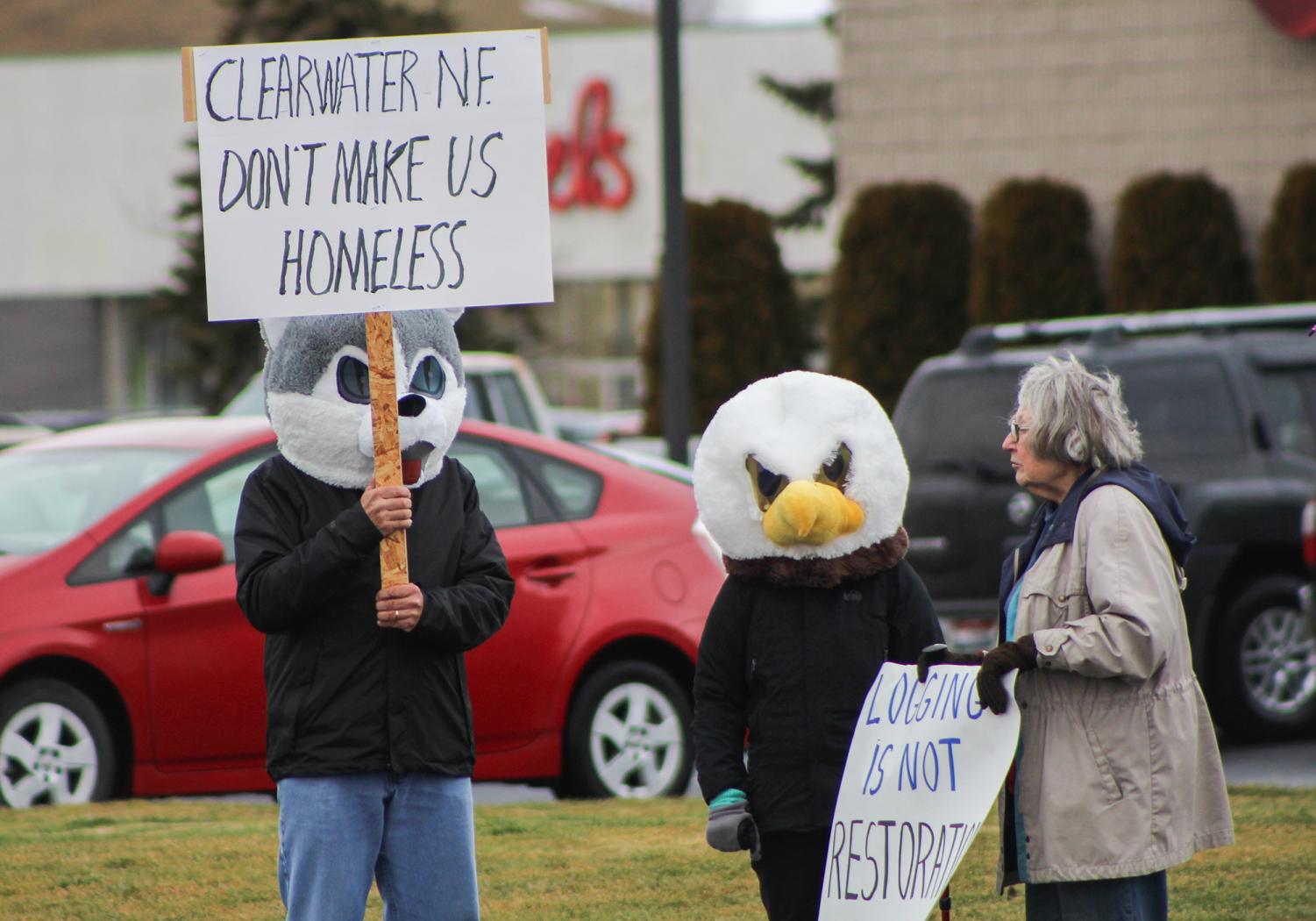
Loren Negron served as the editor-in-chief for fall 2021. She started working for The Daily Evergreen as a news reporter in fall 2019 and moved her way...


Friends of the Clearwater organize event in response to revised plan for Nimiipuu
January 28, 2020
Despite the cold weather, environmental activists protested against the U.S. Forest Service on Saturday in front of Moscow’s Best Western Hotel.
Friends of the Clearwater organized the protest in response to the Forest Service’s Draft Revised Forest Plan and Draft Environmental Impact Statement for the Nez Perce-Clearwater National Forests.
Brett Haverstick, FOC education and outreach director, said the protest was necessary to voice the public’s concerns which are not being heard by the Forest Service’s draft plan.
Protesters waved banners that read: “Protect not Wreck,” “Decolonize the Clearwater,” “Keep $ Out of Policy” and “Logging is not Restoration.”
Several police officers were present during the protest.
Elliott Moffett, president of Nimiipuu Protecting the Environment, said he attended the protest in support of Nimiipuu treaty rights. He said the tribe has resources in those national forests that need protection.
“The Forest was the traditional home of the Nimiipuu (The People). The Nimiipuu were later named the Nez Perce Indians by the Lewis and Clark expeditions,” according to the Forest Service’s website.
Moffett said the Forest Service has a “trust responsibility” to protect the tribe’s treaty rights. He said the agency has mismanaged resources by not giving the Nez Perce people what they were promised to receive.
“We’ve been here, the Nimiipuu, for about 16,000 years, so we’ve seen some of the things that have happened here,” he said. “We’ve seen how nature works.”
After the protest, a public meeting was held by the Forest Service in the Best Western Hotel. Various resource specialists were there to discuss the specifics of the draft plan. Officers were also present at the meeting.
Zach Peterson, forest planner of the Nez Perce-Clearwater National Forests, announced that the deadline for public comment has been extended by Cheryl Probert, forest supervisor of the Nez Perce-Clearwater National Forests. The deadline has changed from March 19 to April 20 which opens public comment for an additional 32 days.
“Public engagement has been really important to us,” Probert said. “I wanted to extend that comment period to continue that history of really engaging the public.”
Gary Macfarlane, FOC ecosystem defense director, handed a 2020 calendar to Probert which included pictures of clear-cuts in the Nez Perce-Clearwater National Forests. Clear-cutting is a logging practice which cuts down most or all trees in an area.
Deborah Gaudet, protest attendee from New Mexico, said she has been a part of the Water is Life movement. She held a sign reading “Protect Weitas Creek.”
Gaudet said she does not believe in siding with the U.S. government.
“It’s a necessary choice for survival, and that is siding with the land and siding with native people,” Gaudet said. “That’s our survival.”
This article is part one of a three-part series on the Nez Perce-Clearwater National Forests and the U.S. Forest Service.
SERENA HOFDAHL | THE DAILY EVERGREEN
Protesters stood outside Moscow’s Best Western Hotel on Jan. 25 holding a sign reading “Save our Forest.” After the protest, a meeting was held by the U.S. Forest Service to talk about the two drafts that were released before the holidays in December.
Releasing drafts right before holidays led to the loss of time for public comment on drafts
The U.S. Forest Service received backlash and disapproval from environmental and conservation groups as well as activists.
Friends of the Clearwater and other activist groups expressed disapproval of the Forest Service’s release and content of two documents. The agency released the Draft Revised Forest Plan and Draft Environmental Impact Statement for the Nez Perce-Clearwater National Forests on Dec. 20 which was the Friday before Christmas.
The Code of Federal Regulations (36 CFR § 219.16(2)) states there needs to be at least 90 days for the public to comment.
Brett Haverstick, FOC education and outreach director, said releasing the documents during the holidays took away about two weeks from the comment period.
He said this is because the public and Forest Service employees are enjoying their holidays. Agency employees may not respond to questions during that time, he said.
“We think it’s actually pretty disgraceful for the government to treat the public like this,” Haverstick said. “This is really a slap in the face.”
A coalition of environmental and conservation groups, submitted a letter asking for the comment period to be extended. The FOC helped lead the coalition.
The letter was dated Dec. 23 and was submitted to Cheryl Probert, forest supervisor of the Nez Perce-Clearwater National Forests.
Probert said the documents were released as soon as they received approval from their “hierarchy process.” She did not define what the hierarchy process was.
Zach Peterson, forest planner of the Nez Perce-Clearwater National Forests, said the Forest Service wanted to release the documents as early as possible. He said groups working with the Forest Service have been waiting years for the documents.
Probert recently extended the comment period’s deadline from March 19 to April 20. She granted an extension of 32 days, although the letter requested an extension of 90 days.
Haverstick said the Forest Service should have done their job well the first time so that the agency would not have to extend the public comment period.
“It’s about establishing credibility and trust with the public,” he said. “When you release a plan the Friday before Christmas, that’s just the opposite. It’s not showing the integrity [of] the government.”
Haverstick said it is important for the public to be given adequate time to review the documents. The DEIS has more than 2,000 pages, while the draft plan has about 500 pages.
Peterson said the draft plan acts as a “rule book” which dictates how the forests should be managed. He said this plan would be in effect for the next 15 to 30 years.
The draft plan contains standards and guidelines which state the desired conditions for resource areas, he said. The standards and guidelines put mandatory constraints on forest project activities such as logging.
The draft plan “has the potential to add nearly 4,000 new jobs to the region and as much as $160 million in additional labor income,” according to the Forest Service’s website.
The DEIS analyzes the plan and evaluates the ecological, social and economic effects it has to resource areas, Peterson said. The document also examines different alternatives.
In the DEIS, it states there are four cooperating agencies involved which includes the counties of Idaho and Clearwater as well as the state of Idaho.
The Nez Perce tribe is listed as one of the agencies, but its status is still pending, according to the DEIS. Probert said this is because a Cooperating Agency Agreement has not been signed yet.
This article is part two of a three-part series on the Nez Perce-Clearwater National Forests and the U.S. Forest Service.

SERENA HOFDAHL | THE DAILY EVERGREEN
Protesters in animal masks stand outside Moscow’s Best Western Hotel on Jan. 25 holding signs reading “Clearwater NF don’t make us homeless.” Another protestor holds a sign reading “Logging is not restoration.” The protest was against two plans created by the U.S. Forest Service which would remove 150 feet from a 300-foot buffer protecting forest streams.
Forest Service’s Draft Revised forest plan lacks “measurable, quantitative standards”
The future of the Nez Perce Forest and the Clearwater National Forest is threatened by two documents released by the U.S. Forest Service in December.
Brett Haverstick, Friends of the Clearwater education and outreach director, said the forests currently operate under two separate plans. He said it is not a good idea to combine both plans into one plan which is the Forest Service’s goal with the Draft Revised Forest Plan.
He said the current plans reflect the diversity of both forests, but the draft plan does not.
Cheryl Probert, forest supervisor of the Nez Perce-Clearwater National Forests, said the two forests were administratively combined in 2013.
She said a single plan was developed to reflect this change “to have a more consistent management approach.” She said the draft plan accounts for the forests’ differences.
Gary Macfarlane, FOC ecosystem defense director, said the draft plan lacks “measurable, quantitative standards.” This means the Forest Service will struggle proving to the public that they are meeting the required standards.
“At the end of the day, you want data-driven science collected, and you want to see those numbers,” Macfarlane said. “If you don’t have that, then it becomes a big, gray area.”
Macfarlane said the draft plan does not protect wilderness areas which are important habitats for species such as grizzly bears and wolverines. The plan also increases logging and endangers the 1.5 million acres of Clearwater’s undeveloped wildlands.
“The [Forest Service] has indicated that any roadless areas not recommended as wilderness in the new forest plan could be developed (logged),” according to the FOC website.
Logging is the process of cutting down trees and removing its wood outside a forest.
Macfarlane said there are streams in the forests which host aquatic species such as native steelhead, native bull trout and salmon. These species require clean water. The streams are protected by a 300-foot buffer which prohibits logging development. However, the buffer is decreased by 150 feet in the draft plan, he said.
He said this poses a problem because native steelhead are currently headed toward extinction in the Columbia River Basin, specifically in the Snake River.
According to National Oceanic and Atmospheric Administration Fisheries, steelhead trout is classified as threatened under the Endangered Species Act.
The FOC held a public meeting Jan. 16 at the 1912 Center in Moscow, Idaho to discuss the content of draft plan. Attendees were encouraged to engage in the public comment process.
During the meeting, Moscow resident and environmental activist Linwood Laughy said standards are often the basis upon which litigation happens. With a lack of standards, there is a lack of accountability, he said.
Another attendee of the meeting, Moscow resident Nils Peterson, said standards are like the white pluses on streets that help people parallel park.
“Having a public standard like that — the white plus — allows people to really assess what they did and assess each other,” Peterson said.
Haverstick said the Forest Service did not include the FOC’s Conservation Biology Citizen Alternative in the Draft Environmental Impact Statement.
The FOC’s alternative was submitted in 2014 and was supported by 13 environmental and conservation groups. The FOC’s alternative generated over 10,000 comments of support, he said.
Macfarlane said the FOC’s alternative protects 100 percent of roadless areas in the forests. The alternative prohibits the use of motorized vehicles such as snowmobiles. The alternative also prevents logging in roadless areas.
He said the FOC’s alternative also reduces carbon emissions and promotes carbon sequestration which is the process of capturing and storing atmospheric carbon dioxide.
“You can log until the cows come home because there’s no side boards there that the agency has to follow,” Haverstick said. “Do away with the standards, and break out the chainsaws. That’s really what the plan is about.”
Individuals can submit their comments concerning the draft plan on the Forest Service’s website.
Zach Peterson, forest planner of the Nez Perce-Clearwater National Forests, said comments will be used to develop the Final Environmental Impact Statement as well as the proposed revised plan. He said the Forest Service will release these documents in March 2021.
This article is part three of a three-part series on the Nez Perce-Clearwater National Forests and the U.S. Forest Service.

Loren Negron served as the editor-in-chief for fall 2021. She started working for The Daily Evergreen as a news reporter in fall 2019 and moved her way...